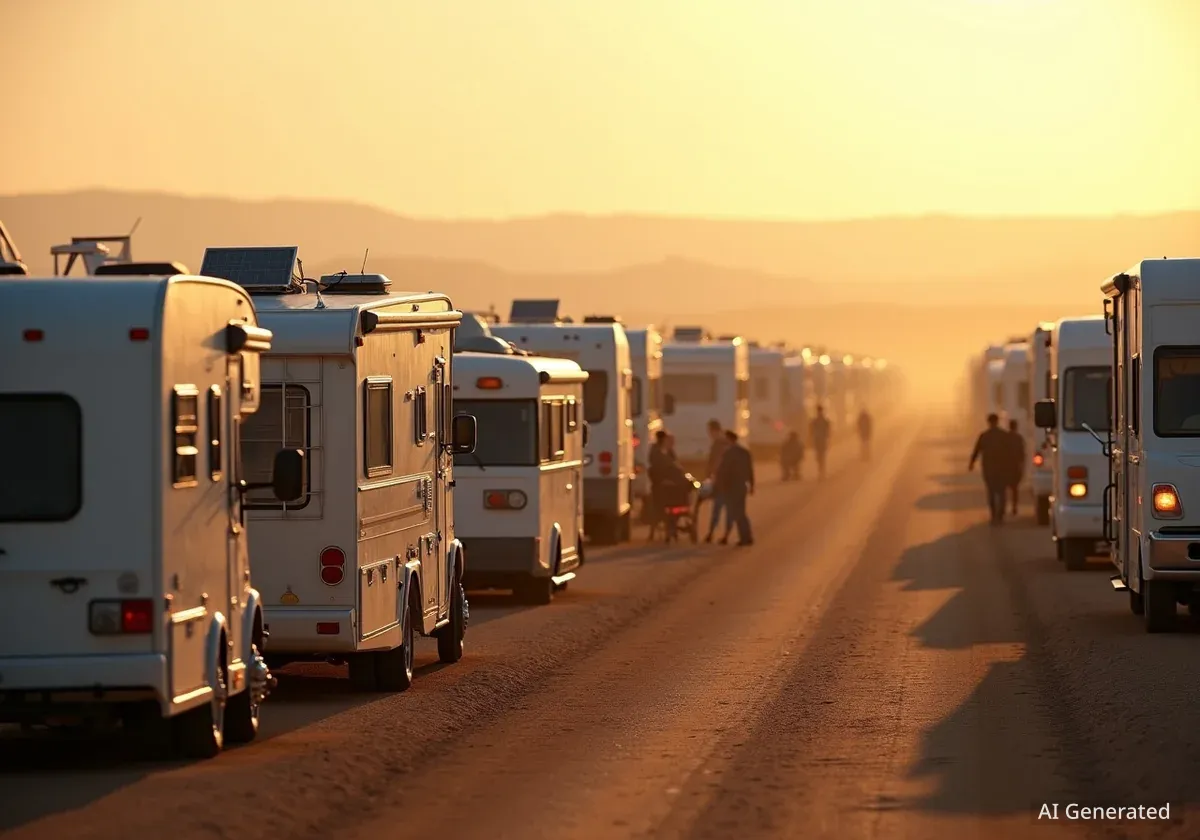A growing number of Americans are turning to recreational vehicles (RVs) for full-time housing as traditional home prices become increasingly unaffordable. The RV Industry Association reports that approximately 486,000 people now live in an RV year-round, a figure that has more than doubled since 2021, signaling a significant shift driven by economic necessity rather than lifestyle choice.
Key Takeaways
- An estimated 486,000 people in the U.S. now live in RVs full-time, more than double the number from 2021.
- This trend is primarily driven by the widening gap between wages and housing costs, not the romanticized "van life" movement.
- A significant portion of full-time RV residents are low-income households, with the vast majority earning less than $75,000 annually.
- About one-third of households living in RVs include children, highlighting the growing number of families impacted by the housing crisis.
A Shift From Recreation to Necessity
The image of RV living has long been associated with retirees exploring the country or young professionals embracing a nomadic, minimalist lifestyle. However, recent data paints a starkly different picture. The current surge in full-time RV residency is less about adventure and more about survival for a growing segment of the population priced out of conventional housing.
According to the RV Industry Association, the demographic of those living on wheels has changed dramatically. A large majority of these residents earn less than $75,000 per year. Furthermore, about a third of these RV households now include children, indicating that families are increasingly forced to find alternative living situations.
This reality stands in sharp contrast to the popular "van life" trend often portrayed on social media, which typically features customized vans and a focus on travel and freedom. For many, the choice to live in an RV is a pragmatic response to an economic squeeze that has made renting or owning a home impossible.
The Economic Forces Behind the Trend
The primary driver behind this housing shift is the severe affordability crisis in the U.S. housing market. Housing costs, which surged during the pandemic, have shown little sign of decreasing. This has created a significant financial barrier for many working-class families and individuals.
The Widening Affordability Gap
An analysis by NBC News highlighted that the gap between what a median household earns and what it costs to afford a median-priced home has stretched to its widest point in nearly a decade. This disparity disproportionately affects hourly wage earners in essential fields like home health care and childcare, as well as retirees relying on fixed incomes from Social Security.
Compounding the issue is broader economic instability. A recent softening in the job market has led to an increase in unemployment applications, which recently hit their highest level in almost four years. At the same time, the rising costs of daily necessities such as groceries, gasoline, and electricity have further strained household budgets, leaving little room for high housing payments.
For many, the cumulative effect of these pressures makes an RV—which can often be purchased for a fraction of the cost of a down payment on a house—the only viable option for shelter.
Data Shows a Rapid Increase in Mobile Living
The numbers confirm this is not a minor trend but a rapidly growing phenomenon. The RV Industry Association's figure of 486,000 full-time residents represents a dramatic increase in a short period. This data is supported by other official sources that have been tracking alternative living arrangements.
Census Bureau Confirms Growth
A separate survey from the U.S. Census Bureau in 2021 estimated that 321,000 people were living in an RV, boat, or van. This represented a 41% increase from its 2019 estimate, underscoring the rapid acceleration of this trend even before the most recent surge.
The consistency across different data sets points to a sustained and growing movement toward mobile living as a primary housing solution. This is no longer a niche community but a significant demographic group that reflects deeper structural problems within the national economy and housing market.
Concerns About Long-Term Suitability
While RVs offer a more affordable roof over one's head, industry experts caution that these vehicles are not designed to serve as permanent homes. This raises concerns about safety, durability, and the overall well-being of long-term residents, especially families with children.
Monika Geraci, a spokesperson for the RV Industry Association, emphasized the intended purpose of these vehicles.
"RVs are recreational vehicles; they are a vehicle; they are built for temporary recreational use. That is how they are built and intended to be used, not as permanent housing."
The construction of an RV differs significantly from that of a traditional home. They are built with lightweight materials for mobility and are often less insulated, making them vulnerable to extreme weather conditions. Issues like plumbing, electricity, and long-term maintenance can also present significant challenges for those living in them full-time without the resources for constant upkeep.
As more Americans are pushed into this lifestyle out of necessity, what was once considered a temporary adventure is now, for many, the only affordable housing option they can find.





